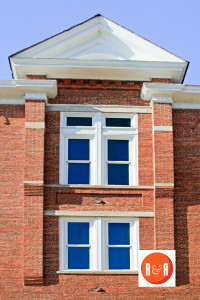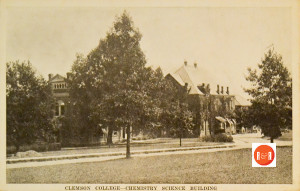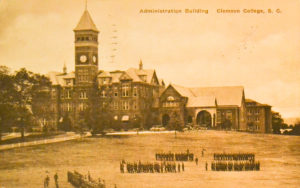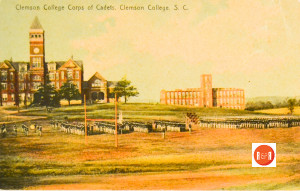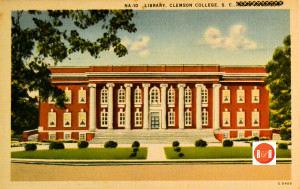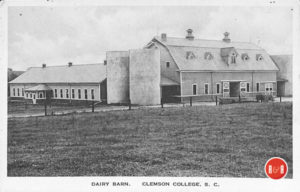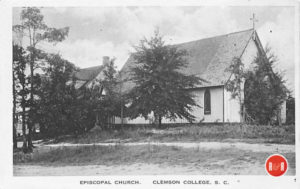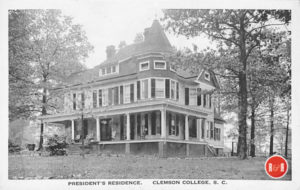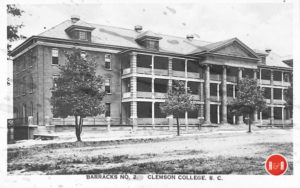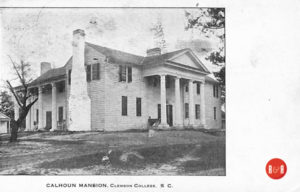Calhoun Circle
The Yorkville Enquirer reported on Aug. 28, 1873 – “On Monday the last rail was laid on the Airline Railroad near the Seneca River in Pickens County and the road is now complete from Atlanta to Charlotte. Later on Sept. 11 they report the total cost of the line was $8,000.000., or an average of $30,000. per mile.”
The Yorkville Enquirer reported on April 16, 1890 – “The deed for the transfer of property bequeathed to the state by the late Thomas G. Clemson has been recorded.”
City Directories and History: Clemson’s main building, Tillman (Hall (Agricultural Hall), was built in 1893 following the establishment of the school in 1889. Architects, Alexander Campbell Bruce and Thomas H. Morgan served as supervisors of the project in the Romanesque Revival style architecture. The interior burned in 1894, was reconstructed in 1895.
View the Clemson NR Historic District images and information at: CLEMSON UN HIST DISTRICT
The Yorkville Enquirer reported on Jan. 29, 1890 – “The first meeting of the board of trustees of the Clemson Agricultural and Mechanical College was held. Colonel R.W. Simpson of Pendleton was elected Chairman and J.E. Wannamaker of St. Matthews was elected Sec. – Treasurer. Other members of the board are: J.L. Orr, R.E. Bowen, D.K. Norris, Allen Johnstone, B.W. Edwards, J.E. Tindal, B.R. Tillman, and M.L. Donaldson. The board appointed committees on curriculum, bylaws, and the construction of necessary buildings. The college is proposed to be established at Fort Hill.” On May 28, 1890 a second meeting was held – “The Clemson Board of Trustees met at Pendleton last week and began work to prepare the grounds for college buildings. Twenty convicts will be put to work felling timber and clearing land on the Fort Hill estate. A contract will be offered for three million brick to be manufactured on the site. Architects are preparing plans for the building. There is also a plan for a rail station on the airline railroad about 1.5 miles from the college.”
The Yorkville Enquirer reported on Jan. 21, 1891 contained a description – “The management of the farm is being established and experiments with agriculture based on scientific principles are underway. Two homes of professors are nearing completion, with their slate roofs being installed, the laboratory building will also be getting a roof soon. This makes three building nearly complete. The cost has 500,000 brick ready for use and the brick plant is capable of producing 30,000 brick a day. A large number of applications from students from all counties in S.C. has been received. Students can be furnished board for $8.00”
March 11, 1891 the Yorkville Enquirer reported, “The trustees of Clemson College met at Pendleton and decided on some of the details of opening the college. It is proposed to open about Feb. 1st of 1892 and the years will be from Feb. 1 – Dec. 1. Ever student will be required to perform manual labor for two hours daily. There will be military discipline and students will wear a uniform of gray. The cost for a poor boy will be board for ten months of $70., medical attention $5., washing $5., uniform and clothing $34., tuition $40. for a total cost of $144. The course will include: math, history and political economy, physics, chemistry, and agricultural studies. The school will be divided into department of agriculture and mechanical.”
The Yorkville Enquirer reported on April 22, 1891 – “The work continues at Fort Hill on the new Clemson College. Building are going up and twenty five thousand bricks are being made daily. The large laboratory building is now complete, and the rock foundation for the mechanical hall is being laid. Two houses for professors are complete and excavations are being made for the dorms for students. Rock is being cut for the foundation for the main college building.”
The Yorkville Enquirer reported on Aug. 5, 1891 – “The cornerstone of the main building at Clemson College was laid at Fort Hill on Tuesday of last week with Masonic ceremonies. About 2,000 people were present, although the program were held in the rain. Addresses were delivered by Gov. Tillman, state Senator Buist, and L.L. Polk, Pres. of the National Alliance.” (The articles also contains a list of items placed in the cornerstone.)
The Abbeville Press and Banner for Nov. 11, 1891 – At Clemson, there are 147 state convicts, all negroes and 18 guards. The camp has a hospital and they are well fed. Three or four convicts have died in the camp and were buried in the graveyard once used for the servants of the Calhoun Estate. The Clemson Farm contains large barns for horses, mules and cattle.”
The Yorkville Enquirer on Jan. 6, 1892 stated – “Clemson College can not be opened in Feb. as planned because the trustees are out of funds and work has been stopped. The legislature decided not to levy a tax which would bring in $65,000. to get all the work done. The school will likely open next February.”
The YV Enquirer reported on July 12, 1893 – “Clemson Ag. and Mech. College opened last Thursday with 300 students. The opening celebration featured Gov. Tillman, Pres. Craighead and Board Members.”
The YV Enquirer of May 23, 1894 – “The Clemson College main building was destroyed by fire on May 22. The chapel and dormitory were saved. The main building contained about 19 rooms and cost about $50,000.” The papers also ran the text from the telegram on this date: A telegram received from Clemson stated, – “Main Building destroyed by fire this morning. Will be able to save chapel and dormitory. Gov. Tillman and Sec. of State Tindall are now here. Many article on first and second floors saved but main building completely gutted.”
On May 30, 1894 – “The investigation is on going into the fire which destroyed the main building at Clemson College. The fire began on the 3rd floor, where thieves had taken some items earlier. The Board of Trustees has decided to begin rebuilding at once. Insurance money of $20,000. has been promised and it is hoped the legislature will provide the rest.”
The YV Enquirer reported on Nov. 7, 1894 – “Work on the main building at Clemson College is being pushed to conclusion, and it is expected to be ready for use when the Feb. term begins.”
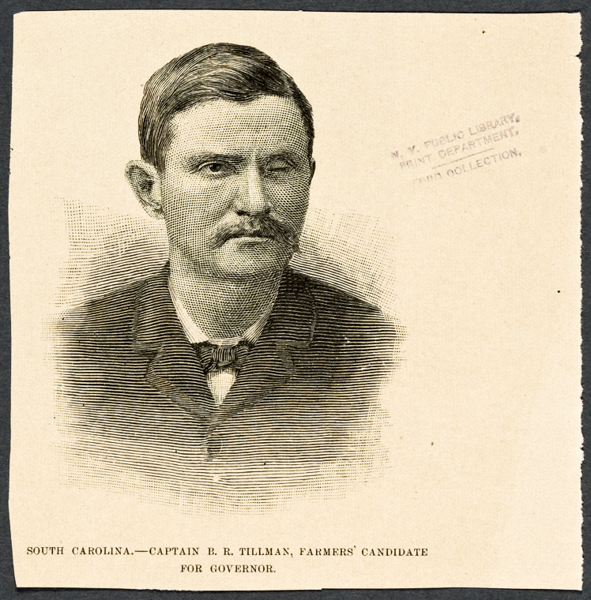
Courtesy of the Miriam and Ira D. Wallach Division of Art, Prints and Photographs: Photography Collection, the New York Public Library. The New York Public Library Digital Collections.

Tillman Hall (Agricultural Hall)
Stay Connected
Explore history, houses, and stories across S.C. Your membership provides you with updates on regional topics, information on historic research, preservation, and monthly feature articles. But remember R&R wants to hear from you and assist in preserving your own family genealogy and memorabilia.
Visit the Southern Queries – Forum to receive assistance in answering questions, discuss genealogy, and enjoy exploring preservation topics with other members. Also listed are several history and genealogical researchers for hire.
User comments welcome — post at the bottom of this page.
Please enjoy this structure and all those listed in Roots and Recall. But remember each is private property. So view them from a distance or from a public area such as the sidewalk or public road.
Do you have information to share and preserve? Family, school, church, or other older photos and stories are welcome. Send them digitally through the “Share Your Story” link, so they too might be posted on Roots and Recall.
Thanks!
IMAGE GALLERY via photographer Bill Segars – 2006 and POSTCARD images courtesy of the Revel Collection – 2015
- Collection of postcards from the Revel Collection of note to Clemson University – 2015
- Clemson’s Episcopal Church




